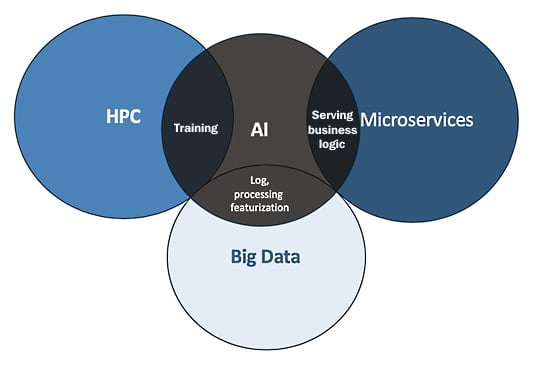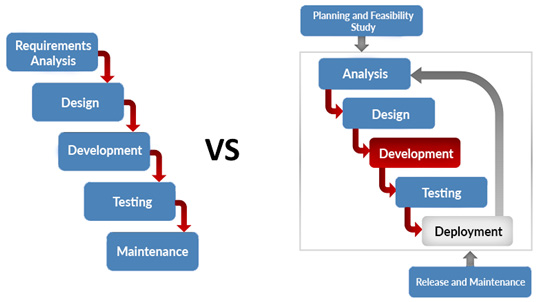The evolution of infrastructure and software development
With the genesis of the modern internet age (around 1995), we witnessed a rise in software applications, ranging from operating systems such as Windows 95 to the Linux operating system and websites such as Google and Amazon, which have been serving the world (online) for over two decades. This has resulted in a culture of continuously improving services by collecting, storing, and processing a massive amount of data from user interactions. Such developments have been shaping the evolution of IT infrastructure and software development.
Transformation in IT infrastructure has picked up pace since the start of this millennium. Since then, businesses have increasingly adopted cloud computing as it opens up new possibilities for businesses to outsource IT infrastructure maintenance while provisioning necessary IT resources such as storage and computation resources and services required to run and scale their operations.
Cloud computing offers on-demand provisioning and the availability of IT resources such as data storage and computing resources without the need for active management by the user of the IT resources. For example, businesses provisioning computation and storage resources do not have to manage these resources directly and are not responsible for keeping them running – the maintenance is outsourced to the cloud service provider.
Businesses using cloud computing can reap benefits as there's no need to buy and maintain IT resources; it enables them to have less in-house expertise for IT resource maintenance and this allows businesses to optimize costs and resources. Cloud computing enables scaling on demand and users pay as per the usage of resources. As a result, we have seen companies adopting cloud computing as part of their businesses and IT infrastructures.
Cloud computing became popular in the industry from 2006 onward when Sun Microsystems launched Sun Grid in March 2006. It is a hardware and data resource sharing service. This service was acquired by Oracle and was later named Sun Cloud. Parallelly, in the same year (2006), another cloud computing service was launched by Amazon called Elastic Compute Cloud. This enabled new possibilities for businesses to provision computation, storage, and scaling capabilities on demand. Since then, the transformation across industries has been organic toward adopting cloud computing.
In the last decade, many companies on a global and regional scale have catalyzed the cloud transformation, with companies such as Google, IBM, Microsoft, UpCloud, Alibaba, and others heavily investing in the research and development of cloud services. As a result, a shift from localized computing (companies having their own servers and data centers) to on-demand computing has taken place due to the availability of robust and scalable cloud services. Now businesses and organizations are able to provision resources on-demand on the cloud to satisfy their data processing needs.
With these developments, we have witnessed Moore's law in operation, which states that the number of transistors on a microchip doubles every 2 years – though the cost of computers has halved, this has been true so far. Subsequently, some trends are developing as follows.
The rise of machine learning and deep learning
Over the last decade, we have witnessed the adoption of ML in everyday life applications. Not only for esoteric applications such as Dota or AlphaGo, but ML has also made its way to pretty standard applications such as machine translation, image processing, and voice recognition.
This adoption is powered by developments in infrastructure, especially in terms of the utilization of computation power. It has unlocked the potential of deep learning and ML.. We can observe deep learning breakthroughs correlated with computation developments in Figure 1.1 (sourced from OpenAI: https://openai.com/blog/ai-and-compute):

Figure 1.1 – Demand for deep learning over time supported by computation
These breakthroughs in deep learning are enabled by the exponential growth in computing, which increases around 35 times every 18 months. Looking ahead in time, with such demands we may hit roadblocks in terms of scaling up central computing for CPUs, GPUs, or TPUs. This has forced us to look at alternatives such as distributed learning where computation for data processing is distributed across multiple computation nodes. We have seen some breakthroughs in distributed learning, such as federated learning and edge computing approaches. Distributed learning has shown promise to serve the growing demands of deep learning.
The end of Moore's law
Prior to 2012, AI results closely tracked Moore's law, with compute doubling every 2 years. Post-2012, compute has been doubling every 3.4 months (sourced from AI Index 2019 – https://hai.stanford.edu/research/ai-index-2019). We can observe from Figure 1.1 that demand for deep learning and high-performance computing (HPC) has been increasing exponentially with around 35x growth in computing every 18 months whereas Moore's law is seen to be outpaced (2x every 18 months). Moore's law is still applicable to the case of CPUs (single-core performance) but not to new hardware architectures such as GPUs and TPUs. This makes Moore's law obsolete and outpaced in contrast to current demands and trends.
AI-centric applications
Applications are becoming AI-centric – we see that across multiple industries. Virtually every application is starting to use AI, and these applications are running separately on distributed workloads such as HPC, microservices, and big data, as shown in Figure 1.2:

Figure 1.2 – Applications running on distributed workloads
By combining HPC and AI, we can enable the benefits of computation needed to train deep learning and ML models. With the overlapping of big data and AI, we can leverage extracting required data at scale for AI model training, and with the overlap of microservices and AI we can serve the AI models for inference to enhance business operations and impact. This way, distributed applications have become the new norm. Developing AI-centric applications at scale requires a synergy of distributed applications (HPC, microservices, and big data) and for this, a new way of developing software is required.
Software development evolution
Software development has evolved hand in hand with infrastructural developments to facilitate the efficient development of applications using the infrastructure. Traditionally, software development started with the waterfall method of development where development is done linearly by gathering requirements to design and develop. The waterfall model has many limitations, which led to the evolution of software development over the years in the form of Agile methodologies and the DevOps method, as shown in Figure 1.3:

Figure 1.3 – Software development evolution
The waterfall method
The waterfall method was used to develop software from the onset of the internet age (~1995). It is a non-iterative way of developing software. It is delivered in a unidirectional way. Every stage is pre-organized and executed one after another, starting from requirements gathering to software design, development, and testing. The waterfall method is feasible and suitable when requirements are well-defined, specific, and do not change over time. Hence this is not suitable for dynamic projects where requirements change and evolve as per user demands. In such cases, where there is continuous modification, the waterfall method cannot be used to develop software. These are the major disadvantages of waterfall development methods:
- The entire set of requirements has to be given before starting the development; modifying them during or after the project development is not possible.
- There are fewer chances to create or implement reusable components.
- Testing can only be done after the development is finished. Testing is not intended to be iterable; it is not possible to go back and fix anything once it is done. Moreover, customer acceptance tests often introduced changes, resulting in a delay in delivery and high costs. This way of development and testing can have a negative impact on the project delivery timeline and costs.
- Most of the time, users of the system are provisioned with a system based on the developer's understanding, which is not user-centric and can come short of meeting their needs.
The Agile method
The Agile method facilitates an iterative and progressive approach to software development. Unlike the waterfall method, Agile approaches are precise and user-centric. The method is bidirectional and often involves end users or customers in the development and testing process so they have the opportunity to test, give feedback, and suggest improvements throughout the project development process and phases. Agile has several advantages over the waterfall method:
- Requirements are defined before starting the development, but they can be modified at any time.
- It is possible to create or implement reusable components.
- The solution or project can be modular by segregating the project into different modules that are delivered periodically.
- The users or customers can co-create by testing and evaluating developed solution modules periodically to ensure the business needs are satisfied. Such a user-centric process ensures quality outcomes focused on meeting customer and business needs.
The following diagram shows the difference between Waterfall and Agile methodologies:

Figure 1.4 – Difference between waterfall and agile methods
The DevOps method
The DevOps method extends agile development practices by expediting software development across the build, test, deploy, and delivery stages. Continuous integration, continuous deployment, and continuous delivery are all part of DevOps, which gives cross-functional teams the autonomy to execute their software applications. It promotes software developers and IT operators to collaborate, integrate, and automate in order to improve the efficiency, speed, and quality of providing customer-centric software. DevOps is a software development methodology that streamlines the process of building, testing, delivering, and monitoring systems in production. DevOps has made it possible to release software to production in minutes and maintain it consistently.
























































